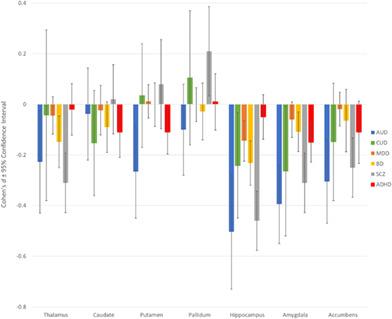当前位置:
X-MOL 学术
›
Hum. Brain Mapp.
›
论文详情
Our official English website, www.x-mol.net, welcomes your
feedback! (Note: you will need to create a separate account there.)
How do substance use disorders compare to other psychiatric conditions on structural brain abnormalities? A cross-disorder meta-analytic comparison using the ENIGMA consortium findings
Human Brain Mapping ( IF 3.5 ) Pub Date : 2020-07-09 , DOI: 10.1002/hbm.25114 Xavier Navarri 1 , Mohammad H Afzali 1 , Jacob Lavoie 1 , Rajita Sinha 2 , Dan J Stein 3 , Reza Momenan 4 , Dick J Veltman 5 , Ozlem Korucuoglu 6 , Zsuzsika Sjoerds 7 , Ruth J van Holst 8 , Rob Hester 9 , Catherine Orr 10, 11 , Janna Cousijn 12 , Murat Yucel 13 , Valentina Lorenzetti 14 , Reinout Wiers 15 , Neda Jahanshad 16 , David C Glahn 2 , Paul M Thompson 16 , Scott Mackey 10, 11 , Patricia J Conrod 1
Human Brain Mapping ( IF 3.5 ) Pub Date : 2020-07-09 , DOI: 10.1002/hbm.25114 Xavier Navarri 1 , Mohammad H Afzali 1 , Jacob Lavoie 1 , Rajita Sinha 2 , Dan J Stein 3 , Reza Momenan 4 , Dick J Veltman 5 , Ozlem Korucuoglu 6 , Zsuzsika Sjoerds 7 , Ruth J van Holst 8 , Rob Hester 9 , Catherine Orr 10, 11 , Janna Cousijn 12 , Murat Yucel 13 , Valentina Lorenzetti 14 , Reinout Wiers 15 , Neda Jahanshad 16 , David C Glahn 2 , Paul M Thompson 16 , Scott Mackey 10, 11 , Patricia J Conrod 1
Affiliation

|
Alcohol use disorder (AUD) and cannabis use disorder (CUD) are associated with brain alterations particularly involving fronto-cerebellar and meso-cortico-limbic circuitry. However, such abnormalities have additionally been reported in other psychiatric conditions, and until recently there has been few large-scale investigations to compare such findings. The current study uses the Enhancing Neuroimaging Genetics through Meta-Analysis (ENIGMA) consortium method of standardising structural brain measures to quantify case–control differences and to compare brain-correlates of substance use disorders with those published in relation to other psychiatric disorders. Using the ENIGMA protocols, we report effect sizes derived from a meta-analysis of alcohol (seven studies, N = 798, 54% are cases) and cannabis (seven studies, N = 447, 45% are cases) dependent cases and age- and sex-matched controls. We conduct linear analyses using harmonised methods to process and parcellate brain data identical to those reported in the literature for ENIGMA case–control studies of major depression disorder (MDD), schizophrenia (SCZ) and bipolar disorder so that effect sizes are optimally comparable across disorders. R elationships between substance use disorder diagnosis and subcortical grey matter volumes and cortical thickness were assessed with intracranial volume, age and sex as co-variates . After correcting for multiple comparisons, AUD case–control meta-analysis of subcortical regions indicated significant differences in the thalamus, hippocampus, amygdala and accumbens, with effect sizes (0.23) generally equivalent to, or larger than |0.23| those previously reported for other psychiatric disorders (except for the pallidum and putamen). On measures of cortical thickness, AUD was associated with significant differences bilaterally in the fusiform gyrus, inferior temporal gyrus, temporal pole, superior frontal gyrus, and rostral and caudal anterior cingulate gyri. Meta-analysis of CUD case–control studies indicated reliable reductions in amygdala, accumbens and hippocampus volumes, with the former effect size comparable to, and the latter effect size around half of that reported for alcohol and SCZ. CUD was associated with lower cortical thickness in the frontal regions, particularly the medial orbitofrontal region, but this effect was not significant after correcting for multiple testing. This study allowed for an unbiased cross-disorder comparison of brain correlates of substance use disorders and showed alcohol-related brain anomalies equivalent in effect size to that found in SCZ in several subcortical and cortical regions and significantly greater alterations than those found in MDD in several subcortical and cortical regions. Although modest, CUD results overlapped with findings reported for AUD and other psychiatric conditions, but appear to be most robustly related to reduce thickness of the medial orbitofrontal cortex.
中文翻译:

物质使用障碍与结构性脑异常的其他精神疾病相比如何?使用 ENIGMA 联盟发现的交叉障碍荟萃分析比较
酒精使用障碍 (AUD) 和大麻使用障碍 (CUD) 与大脑改变有关,特别是涉及额-小脑和中-皮质-边缘电路。然而,在其他精神疾病中也报告了这种异常,直到最近还很少有大规模的调查来比较这些发现。目前的研究使用通过元分析增强神经影像遗传学 (ENIGMA) 联盟方法来标准化大脑结构测量,以量化病例对照差异,并将物质使用障碍的大脑相关性与已发表的与其他精神疾病相关的大脑相关性进行比较。使用 ENIGMA 协议,我们报告了源自酒精荟萃分析的效应量(七项研究,N = 798,54% 是病例)和大麻(七项研究,N = 447,45% 是病例)依赖病例和年龄和性别匹配的对照。我们使用统一的方法进行线性分析,以处理和分割与文献中报道的重度抑郁症 (MDD)、精神分裂症 (SCZ) 和双相情感障碍的 ENIGMA 病例对照研究中报道的相同的大脑数据,以便在各种疾病中效果大小具有最佳可比性. 以颅内容量、年龄和性别作为协变量评估物质使用障碍诊断与皮质下灰质体积和皮质厚度之间的关系。在校正多重比较后,皮质下区域的 AUD 病例对照荟萃分析表明丘脑、海马、杏仁核和伏隔核存在显着差异,效应大小 (0.23) 通常等于或大于 |0。23| 先前报告的其他精神疾病(苍白球和壳核除外)。在测量皮质厚度时,AUD 与双侧梭状回、颞下回、颞极、额上回以及头侧和尾侧前扣带回的显着差异相关。CUD 病例对照研究的荟萃分析表明,杏仁核、伏隔核和海马体积可靠地减少,前者的影响大小与酒精和 SCZ 的报告相当,后者的影响大小约为报告的一半。CUD 与额叶区域的皮质厚度降低有关,特别是眶额内侧区域,但在校正多次测试后,这种影响并不显着。这项研究允许对物质使用障碍的大脑相关性进行无偏见的交叉障碍比较,并显示与酒精相关的大脑异常在几个皮质下和皮质区域的影响大小与 SCZ 中发现的相当,并且在几个方面比在 MDD 中发现的变化显着更大皮层下和皮层区域。虽然适度,CUD 结果与报告的 AUD 和其他精神疾病的结果重叠,但似乎与减少内侧眶额皮质的厚度最密切相关。
更新日期:2020-07-09
中文翻译:

物质使用障碍与结构性脑异常的其他精神疾病相比如何?使用 ENIGMA 联盟发现的交叉障碍荟萃分析比较
酒精使用障碍 (AUD) 和大麻使用障碍 (CUD) 与大脑改变有关,特别是涉及额-小脑和中-皮质-边缘电路。然而,在其他精神疾病中也报告了这种异常,直到最近还很少有大规模的调查来比较这些发现。目前的研究使用通过元分析增强神经影像遗传学 (ENIGMA) 联盟方法来标准化大脑结构测量,以量化病例对照差异,并将物质使用障碍的大脑相关性与已发表的与其他精神疾病相关的大脑相关性进行比较。使用 ENIGMA 协议,我们报告了源自酒精荟萃分析的效应量(七项研究,N = 798,54% 是病例)和大麻(七项研究,N = 447,45% 是病例)依赖病例和年龄和性别匹配的对照。我们使用统一的方法进行线性分析,以处理和分割与文献中报道的重度抑郁症 (MDD)、精神分裂症 (SCZ) 和双相情感障碍的 ENIGMA 病例对照研究中报道的相同的大脑数据,以便在各种疾病中效果大小具有最佳可比性. 以颅内容量、年龄和性别作为协变量评估物质使用障碍诊断与皮质下灰质体积和皮质厚度之间的关系。在校正多重比较后,皮质下区域的 AUD 病例对照荟萃分析表明丘脑、海马、杏仁核和伏隔核存在显着差异,效应大小 (0.23) 通常等于或大于 |0。23| 先前报告的其他精神疾病(苍白球和壳核除外)。在测量皮质厚度时,AUD 与双侧梭状回、颞下回、颞极、额上回以及头侧和尾侧前扣带回的显着差异相关。CUD 病例对照研究的荟萃分析表明,杏仁核、伏隔核和海马体积可靠地减少,前者的影响大小与酒精和 SCZ 的报告相当,后者的影响大小约为报告的一半。CUD 与额叶区域的皮质厚度降低有关,特别是眶额内侧区域,但在校正多次测试后,这种影响并不显着。这项研究允许对物质使用障碍的大脑相关性进行无偏见的交叉障碍比较,并显示与酒精相关的大脑异常在几个皮质下和皮质区域的影响大小与 SCZ 中发现的相当,并且在几个方面比在 MDD 中发现的变化显着更大皮层下和皮层区域。虽然适度,CUD 结果与报告的 AUD 和其他精神疾病的结果重叠,但似乎与减少内侧眶额皮质的厚度最密切相关。











































 京公网安备 11010802027423号
京公网安备 11010802027423号